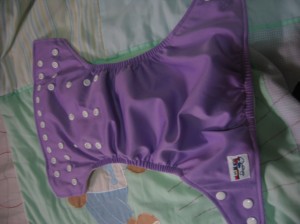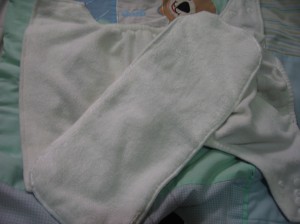Yes, I am an avid recycler just like my mom. We recycle everything and we’re the type that brings reusable bags to the grocery even if we live in QC where it’s not (yet) prohibited to use plastic bags – I’m wishing it were. We also segregate our garbage and do composting since 10 years ago. So what next? My baby’s diapers!
Even when I had my 1st child 5 years ago, I’ve heard of a mother my age actually using cloth diapers on her girls. I tried it the way I knew how – using the age old “lampin” (muslin cloth and the “curity” birdseye cloth). However, it did not work out for us – my baby was always wet all over – lampin, shirt and socks every 15 minutes! I wondered, “how did she ever do it??” I never asked and to this day, I don’t know what her secret is and I don’t really mind not knowing because I have discovered the wonderful (& colorful) world of CLOTH DIAPERING!

Cloth diapers – locally bought
I use cloth diapers just like any disposable. Once it’s full of urine or poop, I put it in a pail for washing. Others, I’ve heard, would change the insert and use the cover again (if urine only)- that also works if you don’t have a lot of “inventory”. I have 9 cloth diapers with inserts and additional 6 inserts I bought separately. This is enough for 1 baby even during the rainy season as I use up only 2-3 diapers a day (I still use disposables at night because they tend to leak…boo!) depending on how many times he poops. These were all locally bought and of the same make. See below.

one size fits most with snaps
This type of diaper is known as a “One size pocket diaper”
Advantages of this type of cloth diapers:
- I don’t really believe in “one size fits all” hence, it’s a “one size fits most” for me. Having those 3 rows of snaps in front makes the rise adjustbale. It can replace a disposable diaper of the size Small to Extra Large and thus is more practical than buying cloth diapers by size (not available in the Philippines as of this post)
- Dries fast. Since the pocket diaper is composed of an outer leak-proof cover and an inner lining of microfleece (only 2 layers), this dries fast. About 4 hours in really sunny weather and 10-12 hours in rainy weather. The insert which is made of 3 layers of microfiber takes longer to dry and that is why I have extra inserts.
- Can opt to change inserts instead of the whole diaper. As I said above, some mothers opt to change just the insert if its full of urine and reuse the pocket diaper. This is okay because the inner lining (made of microfleece) stays dry most of the time.
- Snaps are harder for babies to play around with. At some point, your baby will begin exploring the diaper and try to open it. Snaps just keep in place and very difficult for baby to pry open.

Cloth diaper insert
Disadvantages of this type of cloth diapers (Most of the advantages above can work against you in certain situations):
- The “one size fits most” is just too ambitious. It cannot fit a “new born” baby very well and thus, will leak whatever happens. Most “One size pocket diaper” manufacturers in the U.S. have come up with their “mini” versions (e.g. Happy Heiny’s) if not another line of cloth diapers that is by size. On the other hand, bigger babies or toddlers outgrow this eventually. My SKY is 1.5 years old to date and he is not big at all. He’s using this diaper at its largest and it doesn’t seem like it’s going to last him more than a few month more.
- As snaps are harder for baby to open, it is also hard for caregivers to put on! When you have a baby eager to walk or a toddler who is fussing to get on his feet then, this does take a little time
- “Leak-proof” – not really. I have had leaks with this diaper – both for urine and poop – even if its not that full. For us, it usually comes out at the inguinal area (“singit”) where the inner liner and the outer cover meets. For the 2 months that we’ve been using this, we’ve had about 3-5 leaks only… still not bad
These disadvantages, however, are not enough reason for me to give up cloth diapering. In fact, I’ve done research and to overcome these, I have ordered an imported brand that’s unique in design and proven “leak- free” – Thirsties diapers. That would be on another post.
Other types of cloth diapers:
- All in ones (AIOs)
- Fitteds
- Hybrids
Some brands that can be purchased locally and where…
- The most common type of cloth diaper: One size pocket diaper with snaps. I say common because there are several brands that carry the same make, material and position of tag – even the print is the same. Can be purchased from these brands at the following sites:
- Choochoobaby I bought 6 pairs from her because she has discounts for bulk order. Buy 1 for 350 pesos, buy 3 for 1000 pesos, buy 5 and get 1 free and so on and so forth. She also sells extra inserts for 120/pc (as of this post). Her shipping is 120 pesos because it comes from Davao and when paying at BDO, the buyer needs to shoulder the “access fee” or whatever you call it for 50 pesos.
- Babyland (http://thegoodstuff.multiply.com/photos/album/219/BABYLAND_CLOTH_DIAPER)
- Babyleaf
- Next 9 are available at the following resellers:
- MamaBabyLove www.mamababylove.com
Mothering Earthlings www.motheringearthlings.com
Pinoy Baby Store www.pinoybaby.com
Indigo Baby www.indigomanila.multiply.com
Mom and Baby Essentials mommynbabyessentials.multiply.com
Brussel Sprouts brusselsprouts.multiply.com
- Alva diapers is another kind of One size pocket diaper with snaps . From what I know Alva is made in China (not that the others are not -I just haven’t confirmed their manufacturer). I haven’t used or seen one on hand but from their website, they have the biggest assortment of prints. These can be purchased from http://www.pinkyshop-online-store.com/
- Haute diapers is a little different from the rest – it’s a one pocket diaper with velcro. This is being sold for P400/pc. (http://otysajorda.multiply.com/photos/album/2/Haute_Pockets_Cloth_Diaper_1-size_fits_all_Nappy?x_source=mplist&x_term=alva%20diapers#)
- Bamboo Dappy(http://bamboodappy.multiply.com/) is a one size diaper also but it is made with bamboo. You can choose between snaps and velcro. It’s also being sold at the Medela house for P450/pc (with insert) if I remember correctly. (#29 1st street, New Manila; call for appointment)
- Grovia is an imported brand and can be bought from Sunshine Babies boutique . They have one-size, all-in-two’s, hybrid diapers, diaper covers and other accessories. Since this is imported, one set would cost about 1500 pesos.
- Landmark Dept Store @ Trinoma. I’ve seen an assortment of pocket diapers being sold for P599 each – way expensive – but their insert is the cheapest I’ve seen, P99.75













